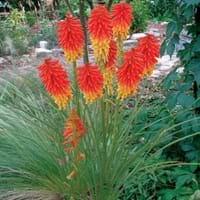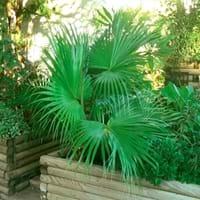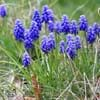Life Span
Perennial
Perennial
Type
Perennial
Palm or Cycad
Origin
Hybrid origin
United States, Southeastern United States, South-Central United States
Types
Not Available
Not Available
Number of Varieties
Not Available
Habitat
Damp Places, Marshy ground
Floodplains, Lowland, River side, Swamps
USDA Hardiness Zone
6-9
7-12
Sunset Zone
2a, 2b, 3a, 3b, 4, 5, 6, 7, 8, 9, 14, 15, 16, 17, 18, 19, 20, 21, 22, 23, 24
H1, H2, 3b, 4, 5, 6, 7, 8, 9, 12, 13, 14, 15, 16, 17, 19, 21, 22, 23, 24
Habit
Clump-Forming
Clump-Forming
Flower Color
Yellow, Red, Orange, Pink
Ivory
Flower Color Modifier
Bicolor
Bicolor
Fruit Color
Not Available
Chocolate, Black
Leaf Color in Spring
Green, Blue Green
Green, Gray Green, Dark Green
Leaf Color in Summer
Green, Blue Green
Gray Green, Dark Green
Leaf Color in Fall
Blue Green, Gray Green, Light Yellow
Green, Gray Green, Dark Green
Leaf Color in Winter
Light Green
Olive, Gray Green, Dark Green
Leaf Shape
Linear
Circular, dissected, long and linear
Plant Season
Spring, Summer
Spring, Summer, Fall, Winter
Sunlight
Full Sun, Partial Sun
Full Sun, Partial Sun, Partial shade
Type of Soil
Clay, Loam, Sand
Clay, Loam, Sand
The pH of Soil
Acidic, Neutral
Acidic, Neutral, Alkaline
Soil Drainage
Well drained
Poorly Drained
Bloom Time
Early Summer, Summer
Early Summer
Tolerances
Drought
Wet Site, Salt
Where to Plant?
Container, Ground
Container, Ground
How to Plant?
Divison, Seedlings
Seedlings, Stem Planting
Plant Maintenance
Medium
Medium
Watering Requirements
Needs more water during establishment, Water Deeply, Water in morning to avoid prompting diseases, Water in the early morning hours
Do Not over Water, Never Over-water, Requires regular watering, Requires watering in the growing season
In Summer
Lots of watering
Lots of watering
In Spring
Moderate
Moderate
In Winter
Average Water
Average Water
Soil pH
Acidic, Neutral
Acidic, Neutral, Alkaline
Soil Type
Clay, Loam, Sand
Clay, Loam, Sand
Soil Drainage Capacity
Well drained
Poorly Drained
Sun Exposure
Full Sun, Partial Sun
Full Sun, Partial Sun, Partial shade
Pruning
Cut or pinch the stems, Remove damaged leaves, Remove dead branches, Remove dead leaves
Remove damaged leaves, Remove dead leaves
Fertilizers
All-Purpose Liquid Fertilizer, Apply N-P-K
fertilize every 2-3 weeks while growing
Pests and Diseases
Onion thrips, Red blotch, Root rot
Insects
Plant Tolerance
Drought, Moisture
Drought
Flowers
Yes
Insignificant
Flower Petal Number
Single
Single
Foliage Texture
Coarse
Bold
Foliage Sheen
Matte
Matte
Allergy
Not Available
Avoid during Pregnancy
Aesthetic Uses
Borders, Cottage Garden, Ground Cover
Beautification, Landscape Designing, Showy Purposes
Beauty Benefits
Not Available
Not Available
Environmental Uses
Air purification
Air purification, Food for insects, Prevent Soil Erosion
Medicinal Uses
Not Available
Asthma, Baldness, Cold, Cough, Migraines, Sore throat
Part of Plant Used
Not Available
Whole plant
Other Uses
Not Available
Decoration Purposes, Employed in herbal medicine, Showy Purposes, Used as Ornamental plant, Used for its medicinal properties
Used As Indoor Plant
No
Yes
Used As Outdoor Plant
Yes
Yes
Garden Design
Container, Cutflower, Mixed Border, Rock Garden, Wall
Bog Garden, Feature Plant, Foundation, Hedges, Mixed Border, Tropical
Botanical Name
KNIPHOFIA 'Border Ballet'
SABAL minor
Common Name
Tritoma, Wisley Blue Spring Starflower, Wisley Blue Springstar
Bush Palmetto, Dwarf Palmetto, Little Blue Stem, Swamp Palmetto
In Hindi
Tritoma
बौना पल्मेट्टो
In German
Tritoma
Zwerg Palmetto
In French
Tritoma
Palmetto nain
In Spanish
tritoma
Palmetto enano
In Greek
tritoma
Νάνος Palmetto
In Portuguese
Tritoma
Palmetto anão
In Polish
Tritoma
Dwarf Palmetto
In Latin
Trytoma
Pumilio Palmetto
Phylum
Tracheophyta
Magnoliophyta
Class
Magnoliopsida
Liliopsida
Order
Asparagales
Arecales
Family
Liliaceae
Arecaceae
Clade
Angiosperms, Monocots
Angiosperms, Commelinids, Monocots
Tribe
Not Available
Not Available
Subfamily
Not Available
Coryphoideae
Season and Care of Tritoma and Dwarf Palmetto
Season and care of Tritoma and Dwarf Palmetto is important to know. While considering everything about Tritoma and Dwarf Palmetto Care, growing season is an essential factor. Tritoma season is Spring and Summer and Dwarf Palmetto season is Spring and Summer. The type of soil for Tritoma is Clay, Loam, Sand and for Dwarf Palmetto is Clay, Loam, Sand while the PH of soil for Tritoma is Acidic, Neutral and for Dwarf Palmetto is Acidic, Neutral, Alkaline.
Tritoma and Dwarf Palmetto Physical Information
Tritoma and Dwarf Palmetto physical information is very important for comparison. Tritoma height is 45.70 cm and width 50.80 cm whereas Dwarf Palmetto height is 240.00 cm and width 240.00 cm. The color specification of Tritoma and Dwarf Palmetto are as follows:
Tritoma flower color: Yellow, Red, Orange and Pink
Tritoma leaf color: Green and Blue Green
Dwarf Palmetto flower color: Ivory
- Dwarf Palmetto leaf color: Green, Gray Green and Dark Green
Care of Tritoma and Dwarf Palmetto
Care of Tritoma and Dwarf Palmetto include pruning, fertilizers, watering etc. Tritoma pruning is done Cut or pinch the stems, Remove damaged leaves, Remove dead branches and Remove dead leaves and Dwarf Palmetto pruning is done Remove damaged leaves and Remove dead leaves. In summer Tritoma needs Lots of watering and in winter, it needs Average Water. Whereas, in summer Dwarf Palmetto needs Lots of watering and in winter, it needs Average Water.





